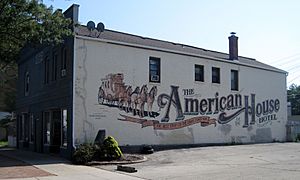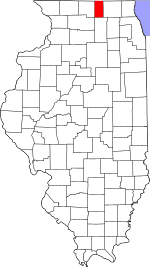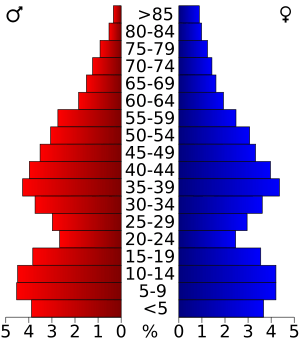Boone County, Illinois facts for kids
Quick facts for kids
Boone County
|
|
|---|---|

Floyd Hopkins Block in the Belvidere North State Street Historic District
|
|

Location within the U.S. state of Illinois
|
|
 Illinois's location within the U.S. |
|
| Country | |
| State | |
| Founded | March 3, 1836 |
| Named for | Daniel Boone |
| Seat | Belvidere |
| Largest city | Belvidere |
| Area | |
| • Total | 282.039 sq mi (730.48 km2) |
| • Land | 280.741 sq mi (727.12 km2) |
| • Water | 1.298 sq mi (3.36 km2) |
| Population
(2020)
|
|
| • Total | 53,448 |
| • Estimate
(2023)
|
53,202 |
| • Density | 189.5057/sq mi (73.1686/km2) |
| Time zone | UTC−6 (Central) |
| • Summer (DST) | UTC−5 (CDT) |
| Congressional districts | 11th, 16th |
Boone County is a county located in the U.S. state of Illinois. As of the 2020 census, the population was 53,448. Its county seat is Belvidere. Boone County is included in the Rockford, IL Metropolitan Statistical Area.
Contents
History
Unlike most of Illinois, much of Northern Illinois was not submerged in a shallow prehistoric sea. As a result, bedrock found in the area now bounded as Boone County is almost entirely Ordovician, as opposed to nearby counties like McHenry and Carroll which contain large areas of later Silurian bedrock. Till and outwash from the Illinoian glaciation covers area bedrock to a depth of several hundred feet. The county's proximity to the driftless area protected the region somewhat from the more recent Wisconsin glaciation. As a result, the county's northern townships resemble a driftless-like area, with higher peak elevations and more surface detail compared to the southern townships dominated by the broad flood plains of the Kishwaukee River and its tributaries.
By the time of the first identified human settlements, the region was made up of thickly wooded forested hills and grassy prairie plains. Archeological study at the Koster Site seems to indicate that humans had established complex societies ten thousand years ago along the river basins of the Illinois and Mississippi. By the time of European exploration, Upper Mississippian culture collapsed; westward expansion forced many Algonquin-speaking nations into conflict with each other as they moved after encroachment of their lands. Potowatomi and Mascouten tribes were still living in the region when white settlers arrived and statehood was declared in 1818.
As a political institution, Boone County was formed in March 3, 1836 out of Winnebago County. It was named for Kentucky frontiersman Daniel Boone. The first non-Native American settlers arrived in what is now Boone County in 1835. They arrived as a result of the end of the Black Hawk War as well as the completion of the Erie Canal. They consisted entirely of settlers from New England. These were "Yankee" settlers, that is to say they were descended from the English Puritans who settled New England in the colonial era. They were primarily members of the Congregational Church though due to the Second Great Awakening many of them had converted to Methodism and some had become Baptists before coming to what is now Boone County. When the New England settlers arrived in what is now Boone County there was nothing but a dense virgin forest and wild prairie. In the late 1870s immigrants began arriving from Germany and Ireland.
Geography
According to the U.S. Census Bureau, the county has a total area of 282.039 square miles (730.48 km2) (99.5%), of which 280.741 square miles (727.12 km2) is land and 1.298 square miles (3.36 km2) (0.5%) is water.
Adjacent counties
- Rock County, Wisconsin - north
- Walworth County, Wisconsin - northeast
- McHenry County - east
- DeKalb County - south
- Ogle County - southwest
- Winnebago County - west
Major highways
 Interstate 90
Interstate 90 US Route 20
US Route 20 Illinois Route 76
Illinois Route 76 Illinois Route 173
Illinois Route 173
Logan Avenue county route 40 Genoa Road (T-40) Garden Prairie Road county route 41 Poplar Grove Road county route 32 Capron Road (T-41)
Climate and weather
| Weather chart for Belvidere, Illinois | |||||||||||||||||||||||||||||||||||||||||||||||
|---|---|---|---|---|---|---|---|---|---|---|---|---|---|---|---|---|---|---|---|---|---|---|---|---|---|---|---|---|---|---|---|---|---|---|---|---|---|---|---|---|---|---|---|---|---|---|---|
| J | F | M | A | M | J | J | A | S | O | N | D | ||||||||||||||||||||||||||||||||||||
|
1.5
28
11
|
1.3
33
16
|
2.4
45
26
|
3.7
59
37
|
4.1
71
47
|
4.6
81
57
|
3.9
85
62
|
4.5
82
60
|
3.3
75
51
|
2.6
63
39
|
2.7
47
29
|
2
33
17
|
||||||||||||||||||||||||||||||||||||
| temperatures in °F precipitation totals in inches source: The Weather Channel |
|||||||||||||||||||||||||||||||||||||||||||||||
|
Metric conversion
|
|||||||||||||||||||||||||||||||||||||||||||||||
In recent years, average temperatures in the county seat of Belvidere have ranged from a low of 11 °F (−12 °C) in January to a high of 85 °F (29 °C) in July, although a record low of −29 °F (−34 °C) was recorded in January 1979 and a record high of 109 °F (43 °C) was recorded in July 1936. Average monthly precipitation ranged from 1.29 inches (33 mm) in February to 4.56 inches (116 mm) in June.
Demographics
| Historical population | |||
|---|---|---|---|
| Census | Pop. | %± | |
| 1840 | 1,705 | — | |
| 1850 | 7,624 | 347.2% | |
| 1860 | 11,678 | 53.2% | |
| 1870 | 12,942 | 10.8% | |
| 1880 | 11,508 | −11.1% | |
| 1890 | 12,203 | 6.0% | |
| 1900 | 15,791 | 29.4% | |
| 1910 | 15,481 | −2.0% | |
| 1920 | 15,322 | −1.0% | |
| 1930 | 15,078 | −1.6% | |
| 1940 | 15,202 | 0.8% | |
| 1950 | 17,070 | 12.3% | |
| 1960 | 20,326 | 19.1% | |
| 1970 | 25,440 | 25.2% | |
| 1980 | 28,630 | 12.5% | |
| 1990 | 30,806 | 7.6% | |
| 2000 | 41,786 | 35.6% | |
| 2010 | 54,165 | 29.6% | |
| 2020 | 53,448 | −1.3% | |
| 2023 (est.) | 53,202 | −1.8% | |
| U.S. Decennial Census 1790-1960 1900-1990 1990-2000 2010-2013 |
|||
| Race / Ethnicity (NH = Non-Hispanic) | Pop 2000 | Pop 2010 | Pop 2020 | % 2000 | % 2010 | % 2020 |
|---|---|---|---|---|---|---|
| White alone (NH) | 35,536 | 40,757 | 36,689 | 85.04% | 75.25% | 68.64% |
| Black or African American alone (NH) | 352 | 976 | 1,171 | 0.84% | 1.80% | 2.19% |
| Native American or Alaska Native alone (NH) | 86 | 68 | 72 | 0.21% | 0.13% | 0.13% |
| Asian alone (NH) | 203 | 667 | 637 | 0.49% | 1.23% | 1.19% |
| Pacific Islander alone (NH) | 3 | 15 | 9 | 0.01% | 0.03% | 0.02% |
| Other race alone (NH) | 13 | 49 | 181 | 0.03% | 0.09% | 0.34% |
| Mixed race or Multiracial (NH) | 374 | 666 | 1,809 | 0.90% | 1.23% | 3.38% |
| Hispanic or Latino (any race) | 5,219 | 10,967 | 12,880 | 12.49% | 20.25% | 24.10% |
| Total | 41,786 | 54,165 | 53,448 | 100.00% | 100.00% | 100.00% |
As of the 2020 United States Census, there were 53,448 people, 18,799 households, and 13,580 families residing in the county. The population density was 189.5 inhabitants per square mile (73.2/km2). There were 20,157 housing units at an average density of 71.5 per square mile (27.6/km2). The racial makeup of the county was 72.5% white, 2.3% black or African American, 1.2% Asian, 0.9% American Indian, 11.6% from other races, and 11.4% from two or more races. Those of Hispanic or Latino origin made up 24.1% of the population. The most common reported ancestries were German (23.7%), Irish (11.7%), Italian (7.4%), and Swedish (7.4%).
Of the 18,799 households, 31.7% had children under the age of 18 living with them, 55.5% were married couples living together, 10.6% had a female householder with no husband present, and 27.8% were non-families. 23.3% of all households were made up of individuals, and 13.0% had someone living alone who was 65 years of age or older. The average household size was 2.82 and the average family size was 3.33.
The county's age distribution consisted of 24.7% under the age of 18, 9.4% from 18 to 24, 23.1% from 25 to 44, 27.1% from 45 to 64, and 15.6% who were 65 years of age or older. The median age was 38.7 years. For every 100 females, there were 99.0 males.
The median income for a household in the county was $70.396 and the median income for a family was $84,450. Males had a median income of $50,213 versus $30,219 for females. The per capita income for the county was $32,659. About 5.0% of families and 8.2% of the population were below the poverty line, including 10.5% of those under age 18 and 6.8% of those age 65 or over.
Education
- Belvidere Community Unit School District 100
- Harvard Community Unit School District 50
- Hiawatha Community Unit School District 426
- North Boone Community Unit School District 200
- Rockford School District 205
Communities
| Community |
Community type |
Population | Total Area |
Water Area |
Land Area |
Pop. Density |
|
|---|---|---|---|---|---|---|---|
| Belvidere | city | 25,339 | 12.38 | 0.24 | 12.14 | 2,087.06 | |
| Caledonia | village | 183 | 1.03 | 0.00 | 1.03 | 176.81 | |
| Capron | village | 1,395 | 0.77 | 0.00 | 0.77 | 1,806.7 | |
| Cherry Valley | village | 2,905 | 8.66 | 0.25 | 8.40 | 345.63 | |
| Poplar Grove | village | 5,049 | 7.67 | 0.01 | 7.66 | 658.88 | |
| Timberlane | village | 906 | 1.76 | 0.02 | 1.75 | 518.90 | |
| Boone County | county | 53,448 | 282.039 | 1.298 | 280.741 | 190 |
Unincorporated communities
- Argyle
- Beaverton Crossroads
- Blaine
- Candlewick Lake
- Edgewood
- Garden Prairie
- Herbert
- Hunter
- Irene
- Prairie View
- Russellville
Townships
Boone County is divided into these nine townships:
- Belvidere
- Bonus
- Boone
- Caledonia
- Flora
- Leroy
- Manchester
- Poplar Grove
- Spring
See also
 In Spanish: Condado de Boone (Illinois) para niños
In Spanish: Condado de Boone (Illinois) para niños



